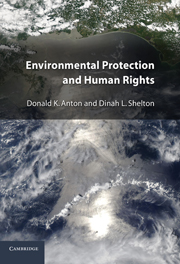Book contents
- Frontmatter
- Contents
- Acknowledgments
- Abbreviations
- Table of Cases
- 1 Law and the Environment
- 2 The Environment as a Human Rights Issue
- 3 An Introduction to Human Rights Origins and Theory
- 4 The International Protection of Human Rights
- 5 International Human Rights Institutions and Procedures
- 6 Procedural Human Rights and the Environment
- 7 Substantive Human Rights and the Environment
- 8 Indigenous Peoples, Rights, and the Environment
- 9 Humanitarian Crises: Armed Conflicts and Other Disasters
- 10 Environmental Rights and International Finance: The World Bank Example
- 11 Human Rights, the Environment, and Corporate Accountability
- Index
1 - Law and the Environment
Published online by Cambridge University Press: 05 June 2012
- Frontmatter
- Contents
- Acknowledgments
- Abbreviations
- Table of Cases
- 1 Law and the Environment
- 2 The Environment as a Human Rights Issue
- 3 An Introduction to Human Rights Origins and Theory
- 4 The International Protection of Human Rights
- 5 International Human Rights Institutions and Procedures
- 6 Procedural Human Rights and the Environment
- 7 Substantive Human Rights and the Environment
- 8 Indigenous Peoples, Rights, and the Environment
- 9 Humanitarian Crises: Armed Conflicts and Other Disasters
- 10 Environmental Rights and International Finance: The World Bank Example
- 11 Human Rights, the Environment, and Corporate Accountability
- Index
Summary
Introduction
Environmental protection emerged as a general public concern in the 1960s, although laws to counter specific local problems like urban air pollution can be found as early as the fourteenth century, when Edward I prohibited the burning of coal in open furnaces in London. More recently, as knowledge has spread about transboundary and global environmental problems, the public has begun seeking widespread preventive and remedial action to ensure that natural conditions remain conducive to life and to human well-being.
Policy makers responding to these demands increasingly understand that environmental protection must be addressed in a holistic and expansive manner. Local problems cannot be separated from national, regional, or even global conditions. As a result, the interface of domestic (both national and local) and international environmental law has rapidly expanded. Such an evolution corresponds to the physical reality of a biosphere composed of interdependent elements that do not recognize political boundaries and the increasingly transnational character of the human activities that harm nature and its processes. Internationalization of markets and the emergence of a global civil society present new opportunities as well as new challenges. Communication networks make possible more rapid knowledge of the existence and scope of environmental problems, but the widespread movement of persons and products may also contribute to those problems, for example, through the introduction of alien species and the spread of pollutants. Overconsumption threatens to exhaust living and nonliving resources, whereas rising greenhouse gas emissions detrimentally modify the global climate.
- Type
- Chapter
- Information
- Environmental Protection and Human Rights , pp. 1 - 117Publisher: Cambridge University PressPrint publication year: 2011



